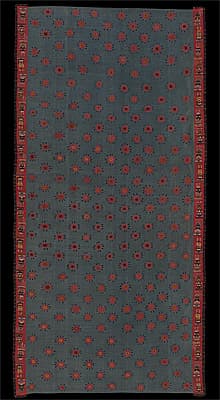
PARACAS culture South coast 700 BC – 200 AD
Mantle with red boarders 700 BC - 200 AD wool and cotton128.0 (h) x 264.0 (w) cm Ministerio de Cultura del Perú: Museo Nacional de Arqueología, Antropología e Historia del Perú, Photograph: Daniel Giannoni
An unusually simple pattern of stars, flowers or suns decorates the textile’s main light-blue-grey field. The stellar motif is embroidered with four alternating colours, two in the circular centre and two for the ten rays or petals. The image is repeated in a regular distribution of staggered rows, and framed at top and bottom by two borders with intricate animal figures. Due to its sobriety and abstract decorative quality, the mantle is sometimes classified as Paracas-Nazca or Paracas-Proto-Nazca1 rather than classical Paracas.
The supernatural beings embroidered on each red border resemble monkey-humans, with protruding tongues, masked faces and striped limbs and tails. Alternatively, they have been identified as feline–human, although lacking cat whiskers and fangs. The creatures wear plain tunics and loincloths, elaborate headdresses with dangling sidepieces, and hold a ritual item, perhaps a vessel. Rather than reversing orientation, as seen in other mantles, the figures line up head to tail in one direction on each border.
Christine Dixon
1. For example, the mantle is identified as Paracas-Nazca in José Antonio de Lavalle and Werner Lang, Culturas precolumbinas: Paracas, Lima: Banco de Crédito del Perú 1983, p. 58, and as Paracas-Proto-Nazca in James W. Reid, Textile masterpieces of ancient Peru, New York: Dover Publications 1986, no. 36. It is regarded as Paracas by Johny Isla, ‘Paracas’, in Peru: Art from the Chavín to the Incas, Paris and Milan: Paris musées/Skira 2006, cat. 55, p. 53.
An unusually simple pattern of stars, flowers or suns decorates the textile’s main light-blue-grey field. The stellar motif is embroidered with four alternating colours, two in the circular centre and two for the ten rays or petals. The image is repeated in a regular distribution of staggered rows, and framed at top and bottom by two borders with intricate animal figures. Due to its sobriety and abstract decorative quality, the mantle is sometimes classified as Paracas-Nazca or Paracas-Proto-Nazca1 rather than classical Paracas.
The supernatural beings embroidered on each red border resemble monkey-humans, with protruding tongues, masked faces and striped limbs and tails. Alternatively, they have been identified as feline–human, although lacking cat whiskers and fangs. The creatures wear plain tunics and loincloths, elaborate headdresses with dangling sidepieces, and hold a ritual item, perhaps a vessel. Rather than reversing orientation, as seen in other mantles, the figures line up head to tail in one direction on each border.
Christine Dixon
1. For example, the mantle is identified as Paracas-Nazca in José Antonio de Lavalle and Werner Lang, Culturas precolumbinas: Paracas, Lima: Banco de Crédito del Perú 1983, p. 58, and as Paracas-Proto-Nazca in James W. Reid, Textile masterpieces of ancient Peru, New York: Dover Publications 1986, no. 36. It is regarded as Paracas by Johny Isla, ‘Paracas’, in Peru: Art from the Chavín to the Incas, Paris and Milan: Paris musées/Skira 2006, cat. 55, p. 53.
An unusually simple pattern of stars, flowers or suns decorates the textile’s main light-blue-grey field. The stellar motif is embroidered with four alternating colours, two in the circular centre and two for the ten rays or petals. The image is repeated in a regular distribution of staggered rows, and framed at top and bottom by two borders with intricate animal figures. Due to its sobriety and abstract decorative quality, the mantle is sometimes classified as Paracas-Nazca or Paracas-Proto-Nazca1 rather than classical Paracas.
The supernatural beings embroidered on each red border resemble monkey-humans, with protruding tongues, masked faces and striped limbs and tails. Alternatively, they have been identified as feline–human, although lacking cat whiskers and fangs. The creatures wear plain tunics and loincloths, elaborate headdresses with dangling sidepieces, and hold a ritual item, perhaps a vessel. Rather than reversing orientation, as seen in other mantles, the figures line up head to tail in one direction on each border.
Christine Dixon
1. For example, the mantle is identified as Paracas-Nazca in José Antonio de Lavalle and Werner Lang, Culturas precolumbinas: Paracas, Lima: Banco de Crédito del Perú 1983, p. 58, and as Paracas-Proto-Nazca in James W. Reid, Textile masterpieces of ancient Peru, New York: Dover Publications 1986, no. 36. It is regarded as Paracas by Johny Isla, ‘Paracas’, in Peru: Art from the Chavín to the Incas, Paris and Milan: Paris musées/Skira 2006, cat. 55, p. 53.

